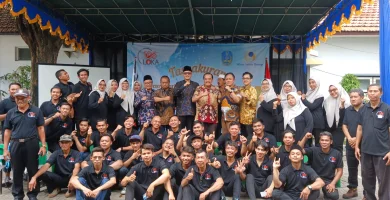 HUT Loka Refractories Wira Jatim ke-105
HUT Loka Refractories Wira Jatim ke-105Dalam kegiatan Tasyakuran hari jadi Loka yang ke 105 tahun pada tanggal 17 Januari 2024 PT. Loka Refractories Wira Jatim lebih kepada memberikan apresiasi terhadap Karyawan Teladan, Karyawan Purna Tugas dan pengangkatan karyawan tetap. Dengan adanya penghargaan terhadap karyawan teladan ini, diharapkan mampu untuk memotivasi karyawan yang lain untuk bisa memberikan kinerja yang jauh lebih baik lagi kedepannya.
Harapan untuk PT. Loka Refractories sendiri adalah dapat menjadi leader dalam Industri Refraktori di Indonesia.
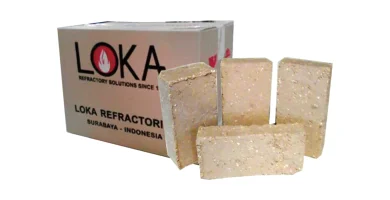 Plastic Material & Ramming Mix
Plastic Material & Ramming Mix Biasanya, kedua material tersebut diaplikasikan pada berbagai macam furnace dan boiler pada industri peleburan baja.
Meskipun cara pengaplikasiannya menggunakan alat yang serupa, kedua material tersebut memiliki perbedaan. Perbedaannya yaitu pada nilai workability index.
Apa itu workability Index (WI)? WI yaitu index penentu sifat plastis material refractory yang pemasangannya dapat dilakukan dengan rammer, gunner, atau vibrator.
Plastic material memiliki workability index lebih besar dari pada ramming mix. Plastic material memiliki nilai WI > 15% sedangkan nilai WI ramming mix < 15%.
Jika pada saat pengaplikasian sampel dengan kadar air tertentu menggunakan rammer terjadi keretakan atau pecah, hal ini menunjukkan bahwa bahan kurang plastis. Oleh karena itu nilai WI dapat digunakan dalam pengembangan material plastic dan ramming mix.
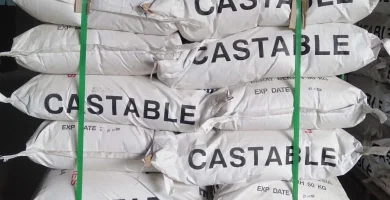 Pedoman Dryout Castable Konvensional
Pedoman Dryout Castable Konvensional· Setelah pemasangan castable, dryout harus dilakukan untuk menghilangkan kadar air sehingga umur lining castable lebih panjang.
Apa saja hal yang perlu diperhatikan saat melakukan dryout? Simak penjelasan dibawah!
Suhu
Suhu dimana bahan ditempatkan adalah hal yang paling penting. Amati prosedur yang direkomendasikan pemasok refraktori.
· Akses Burner
Rencanakan akses yang memadai yang memungkinkan penempatan pembakar kering sementara yang tepat ke dalam unit sehingga pengeringan atau pemanasan yang tepat dapat tercapai.
· Pembentuk
Pembentuk terutama bentuk kayu harus dihilangkan sebelum kering.
Sebagian besar bentuk jaraknya rapat dan cenderung menutupi atau mengisolasi hotface selama tahap kritis awal kekeringan pada suhu rendah.
Bahan kayu atau tabung yang menyala sekitar 230°C sehingga menciptakan suhu tinggi yang tidak terkendali kadang – kadang lebih dari 500°C dan yang mengakibatkan spalling castable dan atau runtuhnya lapisan plastik.
· Termocouples
Selama pemasangan refraktori adalah waktu terbaik untuk memasang termokopel yang tertanam ketika suhu antarmuka dari beberapa lapisan perlu diketahui untuk mendapatkan pemahaman yang lebih baik tentang kerusakan refraktori.
Demikian beberapa hal yang perlu diperhatikan saat melakukan proses dryout refractory jenis castable.
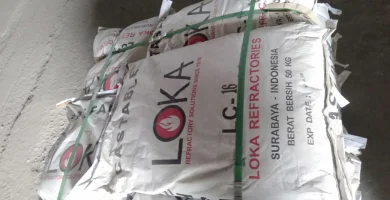 Proses Dryout Castable
Proses Dryout CastablePada saat material castable selesai terpasang, perlu dilakukan suatu proses yang disebut dryout. Dryout yaitu pemanasan awal lining lining castable dengan tujuan menghilangkan air tertinggal tanpa letusan yang menyebabkan lepasnya sebagian material atau explosive spalling.
Proses tersebut dilakukan dengan laju pemanasan dan lama penahanan secara terkendali. Fungsi lain dryout yaitu untuk membentuk jaringan dari susut retakan yang terdistribusi dengan baik.
Beberapa proses dryout diantaranya sebagai berikut.
Proses Dryout
1. Hidrasi adalah proses pembentukan ikatan secara kimia, molekul air dengan senyawa berkontak menjadi senyawa baru hidrat
2. Konversi adalah proses perubahan senyawa metastabil menjadi senyawa yang stabil
3. Dehidrasi adalah pelepasan molekul air oleh senyawa hidrat, umumnya melalui proses pemanasan
4. Curing proses (proses rawat) adalah perioda, dimulai dari dibentuk dengan penambahan air, semen bereaksi dan mengembangkan fasa pengikat hidrat
5. Setting stage adalah tahap awal dari proses curing dari semen mulai menjadi kaku (dari pasta bersifat fluid menjadi padatan kaku)
6. Hardening stage adalah tahap peningkatan kekuatan mekanis setelah tahap pengerasan
Air Dalam Castable
Air dalam Refraktori terdapat menjadi dua bagian, yaitu :
1. Air Pembentukan (Air Mekanis)
Air mekanis yaitu air yang ditambahkan dalam proses pembentukan untuk memodifikasi sifat yang disesuaikan dengan cara pembentukannya (kering, semi kering, plastis, cor). Air ini akan sebagian besar tertinggal di dalam kapiler pori dari bahan sebagai air bebas.
2. Air Hidrat
Air hidrat yaitu air yang terikat secara kimia dengan bahan membentuk hidrat dan dapat dihilangkan tanpa terlalu mengubah komposisi bahan. Proses pementukan hidrat diantaranya sebagai berikut:
- Komposisi mineral anhidrous ditentukan oleh bahan baku dan proses.
- Mineralogi dan kadar hidrat dalam semen ditentukan oleh komposisi mineralogis semen, rasio air – semen, suhu curing.
- Rasio air terhadap semen ditentukan mineralogi dan komposisinya (Air ditambahkan 1/25 komponen semen).
- Air ditambahkan pada konvensional semen 25% terikat sebagai hidrat, pada ultra low 10%.
· Jika laju reaksi hidrasi menurun dengan penurunan suhu curing maka waktu hidrasi semakin panjang.
Penghilangan Air
Beberapa tahapan penghilangan air dari lining castable diantaranya yaitu:
1. Evaporasi, Penguapan air pada suhu dibawah suhu titik didih (Tekanan uap air < Tekanan gas disekitar). Pengendalian evaporasi dapat dilakukan dengan menaikkan tekanan dengan menaikkan suhu refractory, menurunkan kelembaban gas relative, dan menurunkan tekanan gas ambient. Masalah yang sering terjadi yaitu tahapan evaporasi memakan waktu cukup lama.
2. Ebulisi, Penguapan air pada suhu sama atau lebih besar dari titik didihnya (Tekanan uap air ≥ Tekanan gas disekitar). Ebulisi dikendalikan dengan mengendalikan suhu dan laju pemanasan, porositas (melalui pengendalian curing, penambahan serat organic/serbuk logam) , dan curing.
3. Dehidrasi, Pelepasan air hidrat dari bahan.
Intensitas dan lama penghilangan air dari setiap tahapan bergantung pada trayek pemanasan, dan fitur produk seperti permeabilitas, konduktivitas panas, kadar semen, rasio luas permukaan / volume, ketebalan, dll.
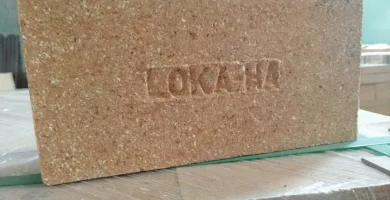 Thermal, Mechanical and Physical Properties of Refractories
Thermal, Mechanical and Physical Properties of RefractoriesRefractory must have thermal, mechanical and physical properties.
What are these characteristics? Scroll down and see the explanation!
Thermal, Mechanical and Physical Properties of Refractory
1. Refractory
Refractoriness is the resistance of the refractory material at high temperatures. This property is also referred to as PCE or Pyrometric Cone Equivalence.
2. Refractory Under Load
RUL is needed to determine the maximum temperature, but under compressive load conditions. RUL is important for knowing high pressure conditions.
3. Permanent Linear Change
Refractory changes after being burned at a certain atmosphere, time and temperature without external pressure. PLC is expressed in percent (%).
4. Thermal Conductivity
The quantity of heat that will flow through a unit area in the direction normal to the surface area in a certain time.
5. Thermal Shock
The refractory's ability to withstand sudden changes in temperature.
6. Porosity
The volume of open pores in a refractory product as a percentage of the total volume, through which liquid can penetrate. The lower the porosity, the better.
7. Cold Crushing Strength
The ability of refractory brick or refractory brick to withstand compression loads at room temperature.
8. Bulk Density
The amount of refractory material in a volume. The greater the bulk density, the greater the volume stability, heat capacity and resistance to slag penetration.
9. Slag Resistance
Resistance to slag is determined by testing the effect of the amount and composition of slag at a certain temperature on the refractory.
There we have the explanation of thermal, mechanical and physical properties of refractories.
If your company needs a refractory for applications in furnaces, boilers and kilns, contact:
Telephone: 0821-4280-8500
E-mail : info@lokarefractories.com
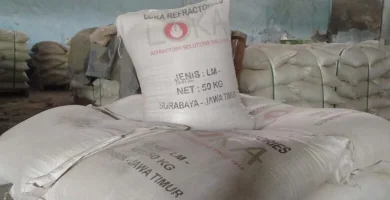 Monolithic Refractory Inspection Methods
Monolithic Refractory Inspection MethodsRefractory inspection methods vary according to type. In this article we will explain inspection methods for monolithic or unformed refractories such as castables, mortars and so on.
Monolithic refractories are inspected using two methods, namely visual inspection and lining inspection for pressure vessels. Check out the explanation below!
Visual Inspection
Some visual inspection methods include the following:
1) Cover Joint Inspection
Check that the mortar or seal between the packings has been packed between the joints properly.
2) Dimensional Inspection
Check dimensions carefully, especially locations where dimensional accuracy must be maintained (e.g. joints with accessories).
3) Repair
If the inspection finds repairs, follow-up with repairs is required after removing the damaged refractory from the repair location. Remove the castable properly to allow the anchor to support the installation of the new refractory.
Some things to pay attention to include:
1. Make sure that the removal does not affect the surrounding normal lining. Also ensure that there are backup materials in case any are damaged by demolition.
2. Clean the area after dismantling the refractory. Replace with only castable of the same type. Also before reinstalling the castable, use fresh water to wet the area ready to be installed that contacts the new castable.
3. To fix the lining, generally the same installation method is used for large areas in the same way as when the initial refractory was installed.
Layer Inspection for Pressure Vessels
Lining inspection for pressure vessels can be carried out using visual or sound waves, and hammer tests.
This inspection is carried out after natural drying and dryout. If necessary, x-rays or other non-destructive tests may be performed for particularly important areas.
Lining inspection methods for pressure vessels include:
1. Inspection after natural drying (24 hours after installation)
a) Ensure that the lining workmanship is satisfactory.
b) Check if there is any reflective material still attached to the gunning surface.
c) Check for cracks.
d) Check dimensions.
2. Hammer Test
The hammer test refers to striking the lining with a hammer, at approximately 300mm intervals to ensure from sound that the lining is installed satisfactorily.
The hammer test is aimed primarily at determining that there is no reflective material attached to the lining being gunned, there are no laminations on the lining that cause peeling, the refractory castable is in contact with the cells and there is empty space in the refractory.
If your company needs a monolithic refractory for applications in furnaces, boilers and kilns, contact us at:
Phone: 0821-4280-8500
E-mail : info@lokarefractories.com


